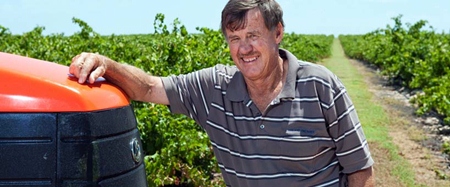You could be forgiven for assuming that this week’s two wines are from different companies. Well, at one time they were, but as so often happens in Australia, smaller wineries are invariably bought out by bigger ones. Both these wines are now produced by Byrne Vineyards, a company with a family history of three generations in the South Australian wine industry.
Byrne Vineyards was established in 1960 and today produces several distinctive wine brands, made from grapes grown in the company’s four vineyards in the Riverland area of South Australia.
 Terry Byrne is in charge of the vineyards.
Terry Byrne is in charge of the vineyards.
The vineyards are in the hands of Terry Byrne, an experienced viticulturalist with a profound understanding of South Australia’s wine regions and grape varieties. With modern winemaking facilities, experienced staff and a family tradition of quality, the staff at Byrne Vineyards controls every step from grape growing to bottling the finished wine.
The story of Thomson Estate dates back to the nineteenth century, when in 1838, Walter and Jane Thomson sailed from Britain to South Australia.
Thomson Estate “Lookout Ridge” Chardonnay 2010 (white), Australia (Bt. 465 @ Foodland)
Even as I was pouring this wine into the decanter, the lovely floral, honeyed Chardonnay aroma wafted into the kitchen. This golden wine has a pronounced greenish tinge so it actually looks more like a Sauvignon Blanc. But the Chardonnay aroma is unmistakable: pineapples, fresh green apples and a touch of honey. I thought I could detect the smell of ripe bananas in the background too.
This mouth-feel of this 100% Chardonnay is satisfyingly fresh and clean, with bucket-loads of fruit up-front. It’s a rich, medium-bodied wine with an amazingly long fruity finish. You’ll find that there’s a good balance of acidity on the taste – not too much, but just enough to give the wine a round and firm body.
This is a very well-crafted wine which you’ll enjoy if you tend to go for big fruity whites. It’s very Australian in style; bold and cheerful in a “Gud eye mite!” sort of way. Even at 14% alcohol content it’s a delightful wine to enjoy of its own. Last year, it won a Gold Medal at the Wine Style Asia awards in Singapore.
Sometimes I think white wines – and especially Chardonnays – are more difficult to pair with food than red wines. This one would work well with salmon dishes, chicken, or pork. It would make a good partner for dishes that use creamy sauces or even mild curry dishes. Try it with a Thai chicken massaman.
Devlin’s Mount Semillon – Sauvignon Blanc 2010 (white), Australia (Bt. 465 @ Foodland)
Outside its native France, Semillon’s most famous home is Australia, where more often than not, it’s blended with Sauvignon Blanc. These two grapes work well in blends even though they are completely different in character. American wine-writer Karen McNeil describes Semillon and Sauvignon Blanc as being like “The Odd Couple”. On its own, Sauvignon Blanc is sometimes tart and sharp, but can be mellowed out by Semillon’s broad, honeyed quality. This Devlin’s Mount wine has been described as being “lean and clean” but I’d go one further and describe it as “lean, clean and green” for this straw-coloured wine has a distinctive greenish hue.
It has a delightful sweet aroma that will probably remind you of lime, honeysuckle and gooseberries. It’s a light-to-medium bodied wine with 13.5% alcohol content. The taste is zesty and fresh; loads of fruit on the palate and a good dash of grapefruit-like acidity. It has a long, dry fruity finish and would make a terrific apéritif to enjoy before dinner. But I think it would make a perfect match for many fish dishes too. Smoked salmon for example, gives the wine a tiny hint of unexpected sweetness. It goes splendidly with Camembert cheese. Forget the old wives’ tale that you always have to drink red wine with cheese. It just ain’t true. You’ll find that this wine “cuts” the creamy texture of the Camembert perfectly. And yes, I tried it, since you asked.
Just in case you’re wondering, the name “Devlin’s Mount” refers to a nineteenth century Irish settler Paddy Devlin, who evidently made his living by selling his home-made wine to passers-by. And by the way, the “Mount” refers to a small local hill, not to Paddy’s horse.




